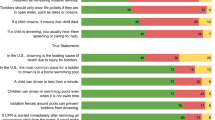Abstract
The basic philosophy of selecting the most appropriate rescue technique by using the over 100-year-old mnemonic, Reach – Throw – Row – Go – Tow remains the gold standard [1, 2]. The rescue categories are arranged by degree of risk and degree of difficulty [2]. The swimming rescue with no form of equipment. Towing with direct physical contact must be the last resort [1, 2]. It should thus be a very rare occurrence. However, over 50 % of 482 trained lifeguards and water safety instructors had engaged in a body contact rescue. This is more than expected as all were trained not to use direct body contact towing, if at all possible. Even more alarming was the fact that for 32 % of these, this was their first ever swimming rescue [3].
Access this chapter
Tax calculation will be finalised at checkout
Purchases are for personal use only
Similar content being viewed by others
References
Royal Life Saving Society Australia (1986) Swimming and life saving. McElroy K (ed). Swimming and lifesaving. RLSSA, Clayton
Royal Life Saving Society Canada (1971) Instructors manual. RLSS, Toronto
Dahl A, Miller I (1979) Body contact rescues – what are the risks? Am J Public Health 68:150–152
Michniewicz R, Walczuk T, Rostkowska E (2008) An assessment of various variants of water rescue. Kinesiology 40:96–106
Wiesner W (2011) Selected elements of lifeguarding education. In: Zukow W, Skaliy A, Napierala M (eds) The state, prospects and development of rescue, physical culture and sport. University of Economy, Bydgoszcz, pp 53–62
Pia F (1974) Observations on the drowning of non-swimmers. J Phys Educ 71:164–167
Reilly T, Iggleden C, Gennser M et al (2006) Occupational fitness standards for beach lifeguards. Phase 2: the development of an easily administered fitness test. Occup Med (London) 56:12–17
Reilly T, Wooler A, Tipton M (2006) Occupational fitness standards for beach lifeguards. Phase 1: the physiological demands of beach lifeguarding. Occup Med (Lond) 56:6–11
Abraldes JA, Soares S, Lima AB et al (2007) The effect of fin use on the speed of lifesaving rescues. Int J Aquat Res Educ 1:329–340
Abraldes JA, Lima AB, Soares S et al (2010) Mannequin carry effort by lifesavers using different types of fins. Facta Univ Ser Phys Educ Sport 8:115–124
Abraldes JA, Soares S, Lima AB et al (2010) Comparison of manikin carry performance by lifeguards and lifesavers when using barefoot, flexible and fiber fins. In: Kjendlie PL, Stallman RK, Cabri J (eds) Proceedings: XIth international symposium for biomechanics and medicine in swimming. Norwegian School of Sport Science, Oslo, pp 42–44
Zamparo P, Pendergast DR, Termin A et al (2006) Economy and efficiency of swimming at the surface with fins of different size and stiffness. Eur J Appl Physiol 96:459–470
Zamparo P, Pendergast DR, Termin B et al (2002) How fins affect the economy and efficiency of human swimming. J Exp Biol 205:2665–2676
Daniel K, Klauck J (1992) Physiological and biomechanical load parameters in life saving. In: Maclaren D, Relly T, Lees A (eds) Proceedings: biomechanics and medicine in swimming, swimming science VI. E & FN Spon, Liverpool, pp 321–325
Rejman M, Wiesner W, Silakiewicz P (2007) Analysis of the usage of the dolphin-kick with fins while body contact swimming rescues. In: Abraldes JA, Rodríguez N (eds) Book of abstract international lifesaving congress 2007. Lifesaving Federation of Galicia, Corunna, pp 141–142
Silackiewicz P, Parnicki F, Rozanski P (2006) The efficiency of body contact swimming rescues performed with or without fins. In: Parnicka U (ed) Rocznik naukowy. ZWWF (in Polish), Biala Podlaska, pp 125–131
Rejman M, Staskiewicz A (2010) Identifying determinant movement sequences in monofin swimming technique. In: Kjendlie P, Stallman R, Cabri J (eds) Proceedings: XIth international symposium for biomechanics and medicine in swimming. Norwegian School of Sport Science, Oslo, pp, 160–162
Hay JG, McIntyre DR, Wilson NV (1975) An evaluation of selected carrying methods used in lifesaving. In: Lewillie L, Clarys JP (eds) Swimming II, proceedings: II international symposium on biomechanics and medicine in swimming. University Park Press, Brussels, pp 247–253
Juntunen P, Leskinen T, Louhevaara V et al (2006) Biomechanics of towing in skilled and less-skilled lifesavers. In: Vilas-Boas JP, Alves F, Marques A (eds) Proceedings: Xth international symposium biomechanics and medicine in swimming, Portuguese Journal of Sport Sciences. University of Porto, Porto, pp 48–50
Juntunen P, Louhevaara V, Keskinen K (2001) Physiological strain of a life saving test-a pilot study. In: Science TGSoS (ed) 6th annual congress of the European college of sport science – 15th congress of the German society of sport science, 24 a 28 de julio, The German Society of Sport Science, Cologne, p 1194
Author information
Authors and Affiliations
Corresponding author
Editor information
Editors and Affiliations
Rights and permissions
Copyright information
© 2014 Springer-Verlag Berlin Heidelberg
About this chapter
Cite this chapter
Stallman, R., Abraldes, A., Soares, S. (2014). Direct Body Contact Swimming Rescues. In: Bierens, J. (eds) Drowning. Springer, Berlin, Heidelberg. https://doi.org/10.1007/978-3-642-04253-9_67
Download citation
DOI: https://doi.org/10.1007/978-3-642-04253-9_67
Published:
Publisher Name: Springer, Berlin, Heidelberg
Print ISBN: 978-3-642-04252-2
Online ISBN: 978-3-642-04253-9
eBook Packages: MedicineMedicine (R0)




